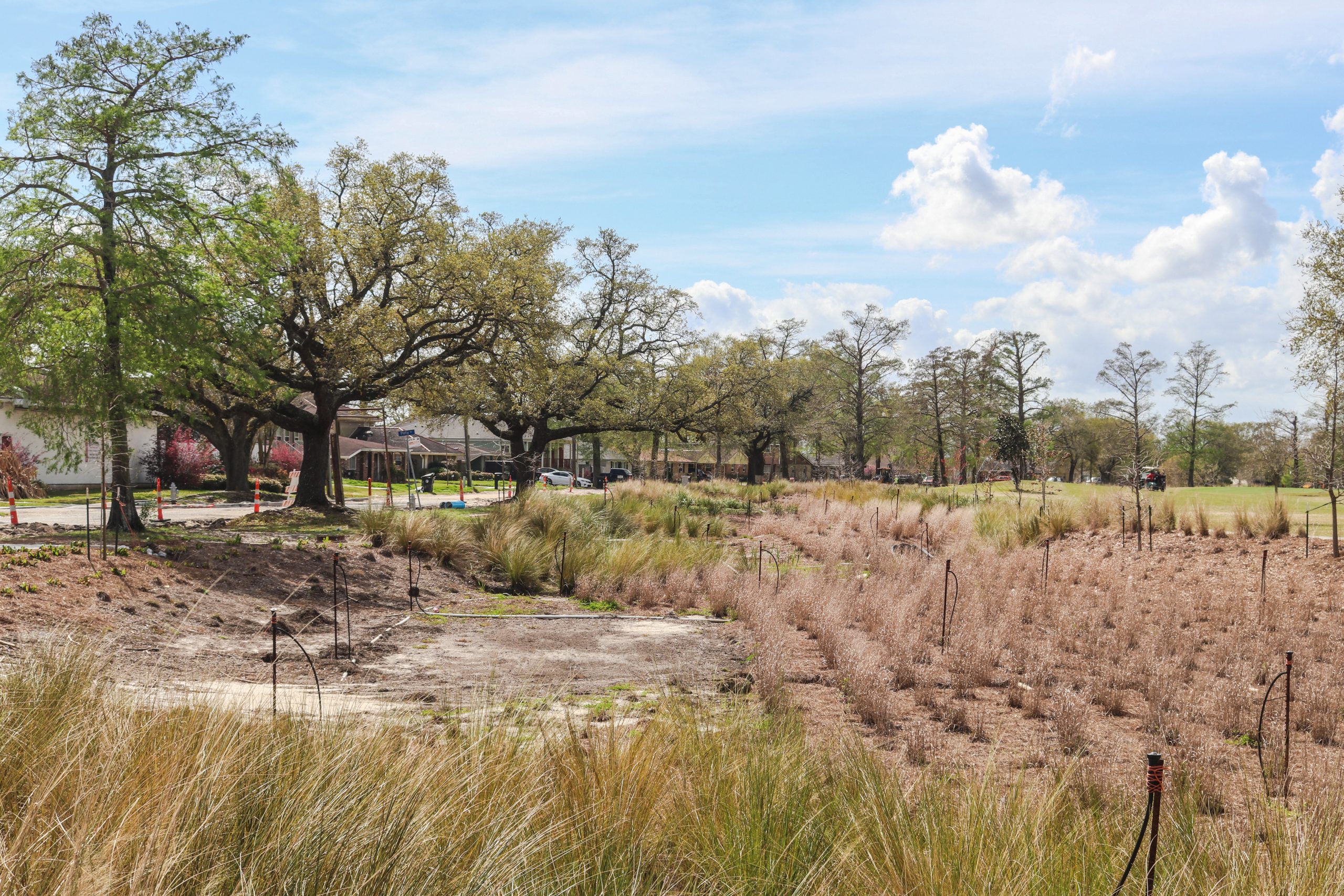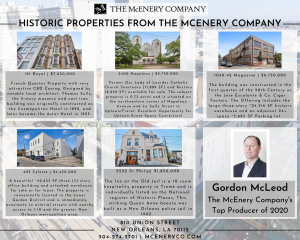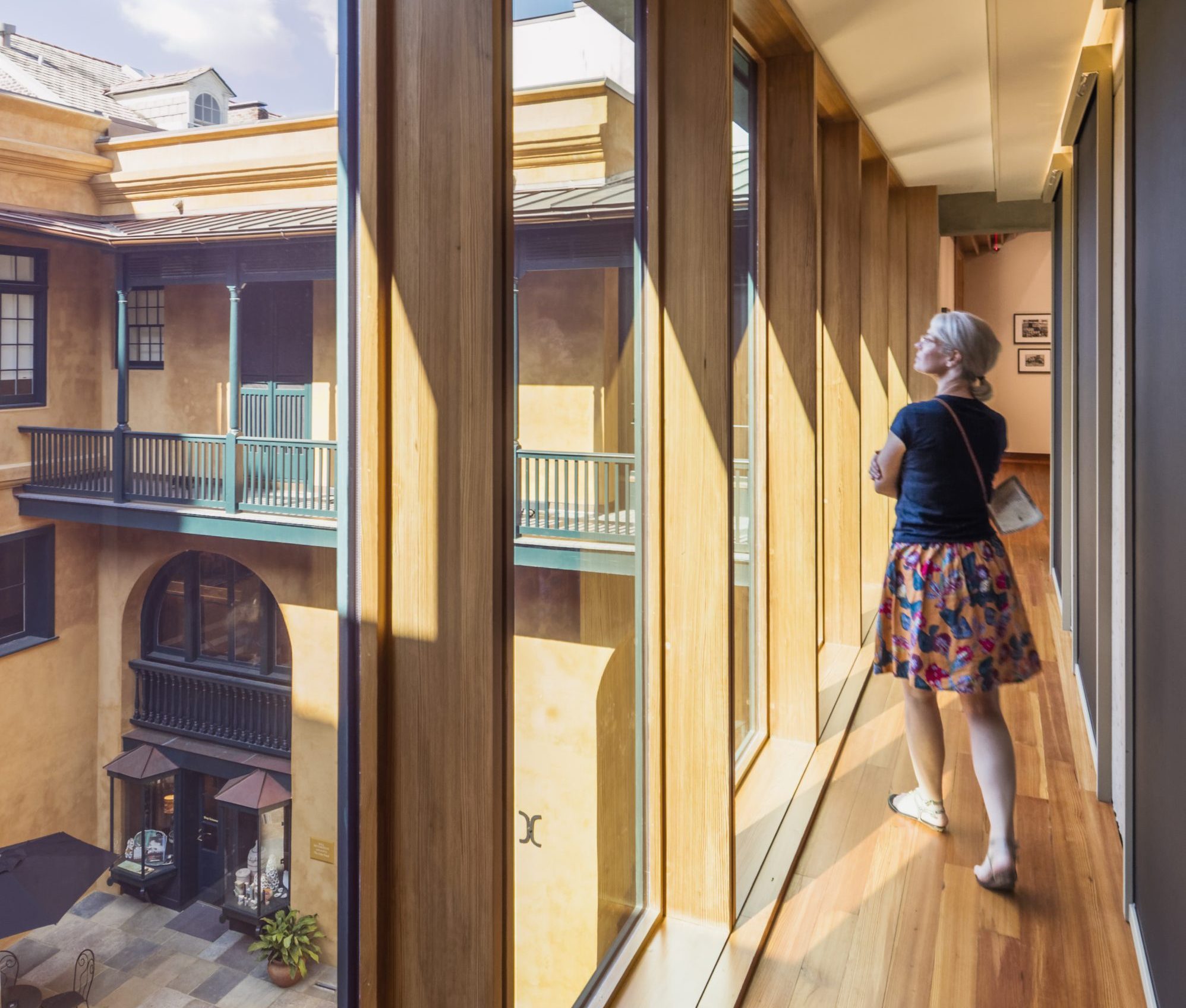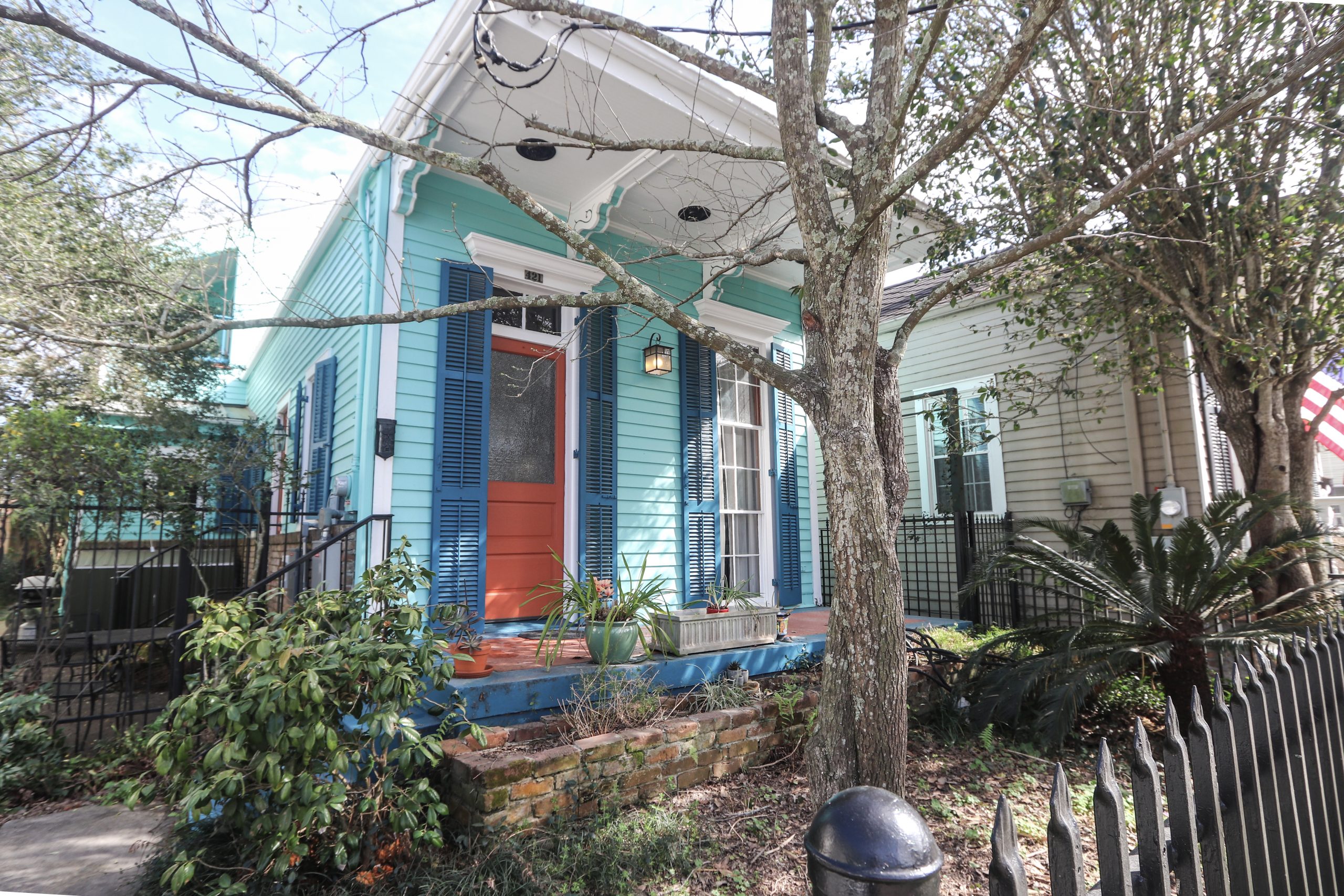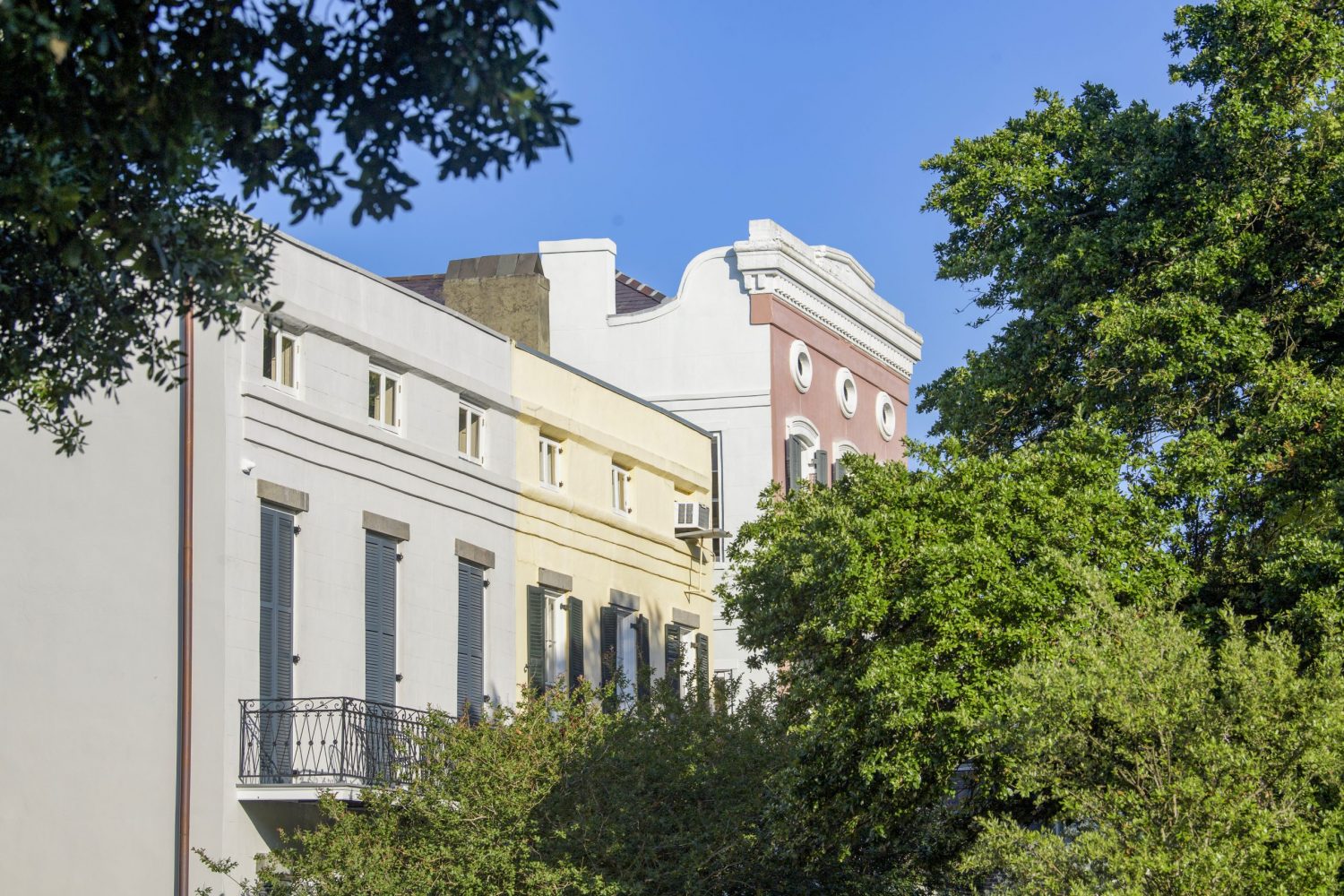This story appeared in the April issue of PRC’s Preservation in Print magazine. Interested in getting more preservation stories like this delivered to your door nine times a year? Become a member of the PRC for a subscription!
While TV screens and Twitter feeds filled with images of street flooding in parts of Gentilly and Mid-City during a downpour in June 2020, Gretchen Bradford, president of the Pontchartrain Park Neighborhood Association, and her neighbors peered from their windows to see if an $18 million public investment in stormwater management would protect their community.
“It works,” she later declared. “The whole city flooded, but we did good in Pontchartrain Park.”
Working with the neighborhood association, Bradford helped resurrect her battered community in the wake of Hurricane Katrina. A subsequent partnership with the Preservation Resource Center culminated when the Pontchartrain Park Historic District was listed on the National Register of Historic Places in 2020. The listing recognizes the unique significance of this planned, post-war suburb built for African Americans in the waning years of Jim Crow.
Now, the area is making history again as the site of a first-in-the-nation stormwater management project. Dubbed Pontilly, its symbolic moniker comes from merging the names of Pontchartrain Park and Gentilly Woods. Once separated by segregation, the two neighborhoods are now linked through a shared network of green infrastructure. Before signing off on the Pontilly project, FEMA had never awarded Hazard Mitigation Grant funding for such a project, which actively diverts rainwater from streets and storm sewers into green spaces where it can be safely stored and absorbed.
The 2005 Katrina disaster saw floodwaters rise to eaves of the area’s single-story, post-war homes. Many property owners chose to repair their homes, but not all. A smattering of vacant lots were left in the hands of the New Orleans Redevelopment Authority. Many of these are being converted to parklets where water is stored. Water detention areas were similarly carved from a pair of linear parcels set aside by the city in the 1950s for a planned extension of Robert E. Lee Boulevard that was never built.
A large curvilinear bioswale excavated along the southern rim of the park’s golf course is now landscaped with native grasses and trees. Parking lanes alongside Press Drive were replaced with a permeable paver system, and additional landscaped rain gardens at intersections will be planted in the near future. All of these interventions work in unison to divert almost 1.2 million cubic feet of stormwater from the conventional drainage system. That’s enough to fill 209,524 bathtubs.
“We got to actually see how the entire system worked,” Bradford said of last year’s deluge. “We watched the water gather in the stormwater lots and bioswales, and how it slowly emptied.” The system is designed to absorb or release all water within 48 hours of a storm, so as to prevent mosquitoes from breeding. That’s one of several community concerns that helped influence the final design after a multi-year process.
Advertisement
COMPLEX PROJECTS
Dana Brown is a landscape architect and planner whose firm worked on the Pontilly design alongside engineers from CDM Smith. “It was a team project,” she said. “We learned a lot from each other.” Using hydrological modeling, the engineers were able to simulate the results of various designs on a complex system of buried pipes and above-ground water retention. The lessons have proved valuable in subsequent projects. “We learned that things that we installed that were perpendicular to that flow were going to be most effective,” Brown said. “The other thing we learned is that the best place to put the green infrastructure to intercept that water is two-thirds of the way up the slope.”
That concept is key to another integrated water management project Dana Brown & Associates helped design to relieve pressure on the network of pipes and canals leading to Drainage Pump Station No. 1 in Broadmoor. That network stretches through Central City into the Garden District and Irish Channel. Those historic neighborhoods developed primarily in the 19th century, and while they boast some of the city’s most iconic architecture, they have relatively little publicly owned green space.
Brown and her colleagues did find one significant parcel: a city square at Seventh and South Saratoga streets near the St. Joseph and Lafayette No. 2 cemeteries. Surrounded by a chain-link fence topped with barbed wire, the long-vacant site formerly housed an incinerator, and the contaminated soil required removal and remediation. That work was recently completed, and the parcel dubbed Saratoga Square will be transformed into a park capable of retaining half a million gallons of water diverted from city streets, or enough to fill 11,281 bath tubs.
In a nod to its setting, Brown said, the team designed a “long winding path to invite contemplation.” Striped pavers were inspired by the notes of the hymn “Just a Closer Walk with Thee,” so “it could actually work if you’re doing a second line.”
The $50 million project also calls for the addition of underground water storage beneath Van McMurray Playground that will accommodate an additional 948,529 gallons, or 18,971 bath tubs, of stormwater.
Advertisement
A similar technique was employed in Mid-City at Easton Park as part of $7 million in upgrades. Linear arched chambers installed below the turf playing field now store rainwater before releasing it into the St. Louis Canal. Designed by the engineering firm Stantech, the Hagan-Lafitte drainage project is not the city’s largest green infrastructure project funded via FEMA Hazard Mitigation Grants, but it does have the distinction of being the first completed.
Permeable sidewalks now line the surrounding streets. Crews from Command Construction replaced the standard-issue yellow “no parking” triangles at intersections with partially curbed rain gardens known as detention cells. Iris and ornamental mulle grass now grow within steps of homes built here in the late 19th and early 20th centuries.
As in many historic New Orleans neighborhoods, the houses have minimal front and side yards to absorb runoff. Managing stormwater in the narrow city-owned right of way helps protect homes and their occupants from nuisance flooding. It’s a strategy the city has plans to deploy in St. Roch and other historic neighborhoods.
The person charged with shepherding those plans to completion is Megan Williams, a New Orleans-born engineer and the city’s stormwater manager. “The goal is to manage water in a more efficient way,” she said. “To provide us with sustainability and assist with climate change impacts. For the last three years, we’ve had larger bursts of rain in shorter time spans.”
New Orleans will always rely on a network of pipes, canals and pumps, Williams said. Supplementing conventional drainage with green infrastructure that “mimics nature,” allows the system to keep pace with increasingly heavy downpours. Ideally, the new integrated approach also beautifies neighborhoods.
Careful plant selection is part of the design process to maximize water absorption while managing maintenance costs. Native plants are the rule. “It will look very different from what some people are used to seeing,” Williams said, “but it will look like those plants are supposed to be there.” She noted that homeowners who want to create a more sustainable city can also adopt native-plant landscaping and install rain barrels to collect water for irrigation.
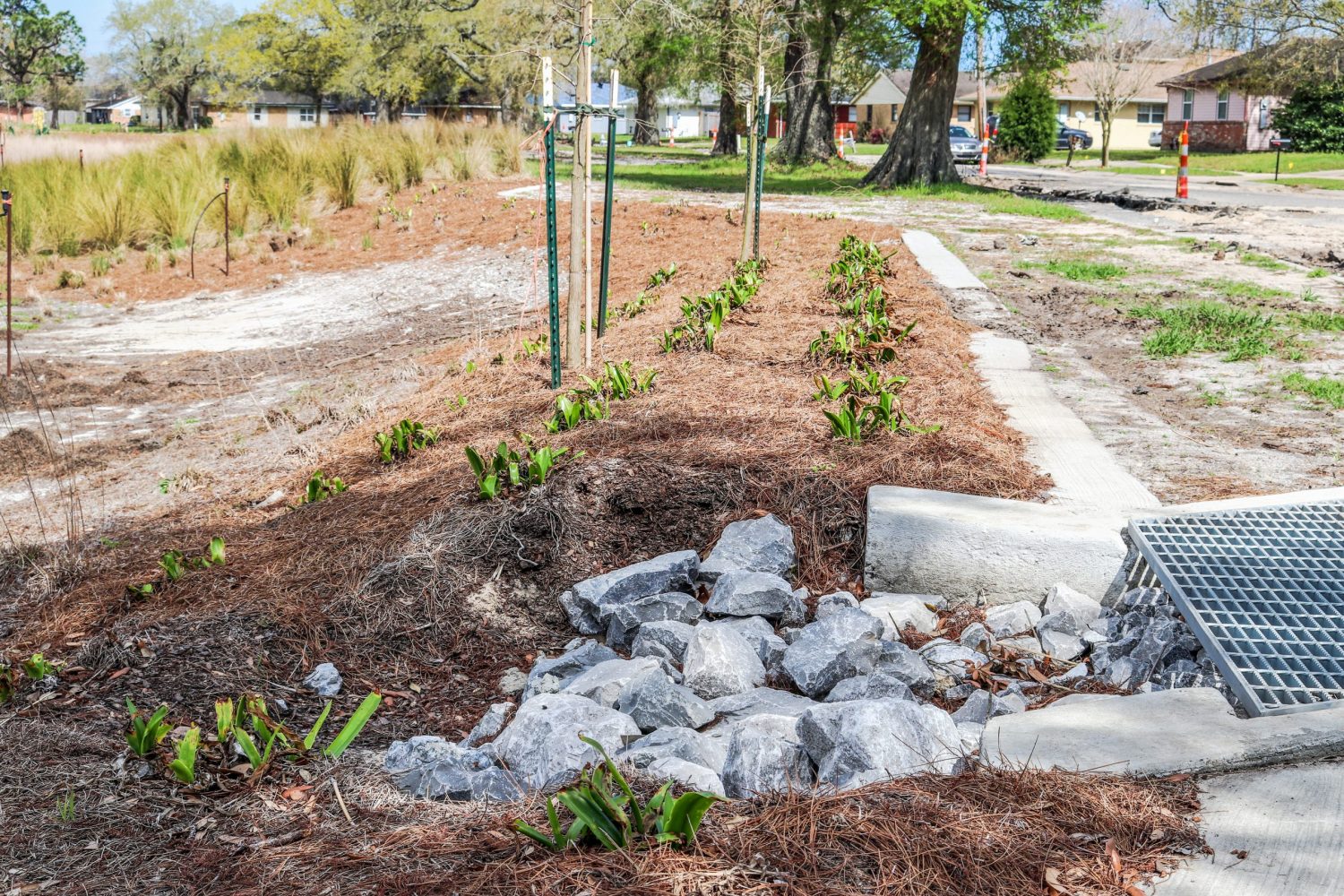
GREEN INFRASTRUCTURE ACROSS THE CITY
Many more New Orleans neighborhoods will see municipal green infrastructure projects in the coming years. A suite of seven federally funded projects known collectively as the Gentilly Resilience District includes a new Mirabeau Water Garden at the former site of the Sisters of St. Joseph’s convent. Other highlights include restored forested wetlands near Dillard University and bike paths alongside a linear waterway in the wide neutral ground of Elysian Fields Avenue. More details are available at nola.gov/resilience-sustainability.
All of this comes a decade after the Louisiana Office of Community Development and GNO Inc. hired the architecture firm Waggonner & Ball to spearhead creation of an Urban Water Plan. The firm had played a key role in the post-Katrina Dutch Dialogues, which brought together experts from New Orleans and the Netherlands. In addition to taking a lead role in designing the Mirabeau project, the firm is now working with the Greater New Orleans Foundation and the Downtown Development District to identify green infrastructure opportunities in the city’s historic core.
At a meeting in March, architect David Waggonner described to the DDD board a combination of open and underground water storage at Duncan Plaza, Armstrong Park and an expanded Lafitte Greenway trailhead. These “hero” projects would combine with “networks” of streetside rain gardens and porous parking lanes as well as “parcel” level improvements, many of which are now required by the building code. “With the proposed scenario, we get to a 39 percent flood reduction in the area,” Waggonner told the board.
Significant rush hour street flooding in July of 2019 underscored the need for green infrastructure downtown. As plans developed, the ongoing rehabilitation of the former Charity Hospital emerged as a key opportunity. Waggonner’s team has proposed numerous streetside improvements, parklets and roof gardens for the Charity vicinity.
In addition, Tulane University, which is an anchor tenant for the Charity Hospital redevelopment, has proposed to play a lead role in fundraising for an overhaul of Duncan Plaza to include subterranean water storage, according to DDD interim director Richard McCall. That’s welcome news, given a price tag north of $6.5 million.
A cost estimate for the total proposed scenario tops $67 million. (Details are available here) The lion’s share of that would be used to create a Lafitte Blueway, effectively reintroducing water to what was once the turning basin of the Carondelet Canal. It’s an ambitious concept rooted in history.
Ambition, however, may be the answer. “No other city in the world has the problems New Orleans has,” Williams said. “That really excites me as an engineer. This is forcing us to be creative and really think outside the box. When it rains, I see opportunity.”
Nathan Lott, PRC’s Policy Research Director and Advocacy Coordinator, can be reached at nlott@prcno.org.
Advertisements



